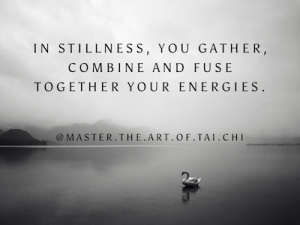Tai Chi movements are achieved through relaxation.
Your movements are primarily not using your muscles or any kind of tension to move your body. Your movements flow towards or away from a point of origin. Since the point of origin is within your body and at your center (the lower dantien), you are moving in and out from the center within your body.
The Tai Chi Classics will say it is proper to “open and close” when moving away and towards the point of origin. What does this mean in the practice of Tai Chi?

You are using opening and closing methods for expanding and contracting. When you expand and contract, you cause the energy to flow abundantly. This is why you do Tai Chi – to move your energy abundantly. You do so by using the opening and closing methods taught by your teacher. There are many interpretations of opening and closing. It depends on the lineage and the background in which Tai Chi is taught. It really depends on your teacher.
My interpretation
In order to move your energy, embody physical, mental, and energetic relaxation. You start in stillness. And from stillness, you then go into motion.
In stillness, you gather, combine and fuse together your energies.
In motion, you separate, disperse and spread out your energy.
Therefore, you close stillness and you open in motion. These are the two general states that we find ourselves in.
The concept of opening and closing also refers to your body and the Chi. When your body opens, your Chi closes. When your body closes, your Chi opens…
Are you confused yet?
When I am exhaling, letting go, I open the body as a result. The Chi condenses, combines, gathers and sinks in. As you exhale, open the body. Then, when you energize and close the body, your Chi opens, disperses, and comes out in the movement.
When working out the upper body, you may engage the shoulders to move the arms. However, you can only do so much with your shoulder blades. You need something else to give you that extra power.
You need to have a good firm foundation, first. This is created by settling down into your feet. When you have a strong stance, then you can use your pelvic joint to act as a pivoting point for your body to turn. This helps your shoulder to act as a pivoting point for your arm to swing.
Exhale, relax, open the arm and then energize swing the arm out, turning the torso hinge.
Imagine watching a tennis player in slow motion. The tennis player hits the ball by establishing a strong foundation and root created by the foot. When you do a back hand, you energize from the foot. You pivot along the pelvic joints, and then work your way up the body with your energy. Finally, you pivot on your shoulder blades to do a backhand movement in tennis.
To understand the opening and closing techniques of Tai Chi, it’s essential to understand the implications of the yin-yang principle in Tai Chi.
Yin closes.
Yang opens.
In Tai Chi, open simply means physically opening your shoulder blade and pelvic joints, outwards away from your center.
Close means moving inward towards your center.
You can also think of bending and extending at the same time as you are closing and opening.
As your arms extend and retract during Tai Chi movements, your elbow pit alternates between becoming larger which is opening up, and smaller by closing. Internally, you use your mind’s intent to influence the motions.
Here’s a secret: Opening and closing happen simultaneously throughout your body in the Tai Chi form.
Don’t worry too much about when you are opening and closing. Just have fun with your form!
Let’s do some Tai Chi, and follow along with my video to see the opening and closing movements.
Let’s begin by going into the ‘single whip’ position.
1. Exhale, open the body.
2. Energize, close the body.
Let’s do that again.
1. Exhale, heel up.
2. Open the body.
3. Energize.
4. The body closes. Raise hands.
Tai Chi is done in slow motion.
You can be in a semi-meditative state. Focus your mind on the relevant hinges or joints during the movements. For example, when you exhale, open your body, and place your mind on opening your joints.
Then when you energize, you close the shoulder joints and raise your hands. Opening and closing happen simultaneously.
So the slower you do Tai Chi movements, then the stronger you feel the resistance coming from opening and closing the joints. This gives your body a good internal workout.
What if you can get a nice workout from feeling the resistance of your joints yourself?
How do you synchronize your breathing during the movements?
Follow me on Instagram and find out how you can incorporate breathing techniques into the opening and closing methods of the physical form.


0 Comments